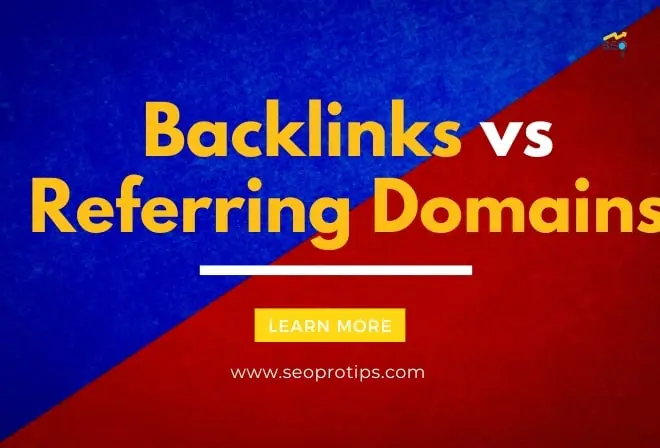Backlinks and referring domains play a pivotal role in determining your website’s ranking. This guide will break down these terms, highlight the importance of each, and offer insights on how to leverage both to achieve SEO success.
What Are Backlinks?
Backlinks, also known as inbound links, are links from one website to another. They act as endorsements for your content, signaling to search engines that your site is valuable.
| Statistic | Value |
| Average Backlinks per Top 10 Google Result | 375 backlinks |
| Percent of Websites without Backlinks | 94% |
| Impact of 1 High-Quality Backlink on SEO | Equivalent to 50 low-quality backlinks |
What Are Referring Domains?
Referring domains are unique websites that provide backlinks to your site. Even if a site links to you multiple times, it’s counted as one referring domain.
| Statistic | Value |
| Sites with Higher Ranking on Google | Average of 100+ referring domains |
| Impact of Diverse Referring Domains | Increases domain authority significantly |
The Difference Between Backlinks and Referring Domains
While backlinks are individual links to your site, referring domains are unique websites that provide these links.
| Metric | Example |
| Backlinks | 50 links from Site A |
| Referring Domains | 1 (Site A as the source) |
Why Are Backlinks Important for SEO?
Backlinks act as votes of confidence from other sites, boosting your page’s authority and helping you rank higher.
| Metric | SEO Impact |
| 10 High-Quality Backlinks | Can boost your ranking by 5-10 positions |
| 100 Low-Quality Backlinks | Minimal impact; may even hurt SEO |
Why Are Referring Domains Important for SEO?
Diverse referring domains show search engines that multiple sources find your content valuable. Google’s algorithm favors sites with a wider range of unique linking sources.
| Number of Referring Domains | SEO Impact |
| 10 Referring Domains | Moderate increase in domain authority |
| 100 Referring Domains | Significant boost in search rankings |
How Backlinks and Referring Domains Complement Each Other
A balanced strategy that combines high-quality backlinks from a wide range of referring domains is most effective for SEO.
| Metric | SEO Benefit |
| High-Quality Backlinks | Increases page authority |
| High Diversity of Referring Domains | Enhances domain trustworthiness |
Types of Backlinks
- Follow Backlinks: Pass authority to your site and boost your SEO.
- No-Follow Backlinks: Don’t directly affect SEO but can drive traffic.
- Editorial Backlinks: Earned naturally when others link to your content.
- User-Generated Backlinks: Links from user comments or forum posts.
| Type of Backlink | SEO Value |
| Follow | High |
| No-Follow | Low, but can boost traffic |
Types of Referring Domains
- High-Authority Domains: Well-regarded sites that pass strong SEO value.
- Low-Authority Domains: Less reputable, offering limited SEO benefit.
- Niche-Relevant Domains: Sites within your industry, signaling relevance.
| Referring Domain Type | Impact on SEO |
| High-Authority | Significant boost to domain authority |
| Low-Authority | Minimal impact |
| Niche-Relevant | Enhances topical relevance |
Backlink Quality vs. Quantity
Focusing on quality over quantity is crucial for backlinks. High-quality backlinks from reputable sources significantly impact SEO.
| Backlink Quality | SEO Impact |
| 10 High-Quality Backlinks | Boosts domain authority greatly |
| 100 Low-Quality Backlinks | Minimal or negative impact |
Referring Domain Diversity vs. Quantity
Diverse referring domains contribute more to SEO than multiple links from the same site. Search engines view diverse domains as a sign of broad trustworthiness.
| Diversity of Referring Domains | SEO Benefit |
| 10 Unique Referring Domains | Moderate improvement |
| 50 Unique Referring Domains | Significant boost in SEO performance |
How to Get High-Quality Backlinks
- Create Shareable Content: Publish valuable, engaging content others want to link to.
- Guest Blogging: Write for reputable sites in exchange for backlinks.
- Broken Link Building: Find and replace broken links on other sites with links to your content.
| Method | Success Rate |
| Shareable Content | High |
| Guest Blogging | Moderate |
How to Increase Referring Domains
- Outreach Campaigns: Contact websites within your industry to share your content.
- Collaborations: Partner with others for mutual backlinking benefits.
- Press Releases: Announce newsworthy updates to attract media coverage and links.
| Strategy | Expected Increase in Referring Domains |
| Outreach | High |
| Press Releases | Moderate |
Monitoring Backlinks and Referring Domains
Using SEO tools to track these metrics is essential for understanding your progress and refining your strategy.
| Tool | Best For |
| Ahrefs | Comprehensive backlink analysis |
| Moz | Referring domain insights |
| SEMrush | Competitor backlink tracking |
Conclusion
In summary, backlinks and referring domains are both essential elements for SEO success. High-quality backlinks boost authority, while diverse referring domains increase trustworthiness. By combining both, you create a well-rounded SEO strategy that can lead to sustained growth.
FAQs
- How many backlinks do I need for SEO?
Focus on high-quality, relevant backlinks rather than a set number. - What is the ideal number of referring domains?
The more unique, authoritative referring domains you have, the better. - Can too many backlinks hurt my SEO?
Yes, if they come from low-quality, spammy sources. - Are all referring domains equally valuable?
No, high-authority, niche-relevant domains are more beneficial. - How do I disavow bad backlinks?
Use Google’s Disavow Tool to remove harmful links.

